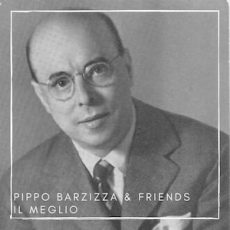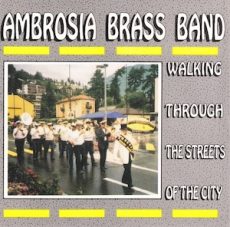
Daily Dose Of Jazz…
Giuseppe “Pippo” Barzizza was born on May 15,1902 in Genova, Italy. He was a child prodigy and at age six he entered the Camillo Sivori Institute to study violin, quickly passing the exam and taking his first award. He could hardly read words but he was already able to write a Mozart symphony without error.
After attending primary and secondary schools he went to Cristoforo Colombo High School, where he studied violin at the Conservatory. Listening to his father’s phonograph, Pippo developed a passion for classical and symphonic music. He became skilled in mathematics and decided to follow mathematical studies, graduating as an engineer.
Barzizza also studied harmony, counterpoint, composition, and instruments. He focused on the piano until 1933, followed by the violin, banjo and the trumpet section. During this period he was the lead violinist at Politeama and performed music for silent movies at the cinema near his home.
By seventeen he had stopped his violin studies for the pursuit of conducting and composition. For the next four years he performed on ships and for orchestras in Genova. However, it was in New York City he first heard jazz and swing music. Through the 1920s Pippo became a skilled arranger, joined an orchestra, served in the Italian Army and founded a military orchestra.
His first line up was playing violin for Blue Star Orchestra, then he conducted the Cetra Orchestra, recorded during the Thirties for Fonit, Columbia, La Voce del Padrone, Odeon, Brunswick and Fonotipia record labels. Post World War II he played on soundtracks and counducted the Modern Orchestra. Retiring from music in 1960 he taught music, established a recording studio in his home
At the age of 92, composer, arranger, conductor and music director Pippo Barzizza, who was active from 1924 to 1960 playing violin, piano, saxophone, banjo, and accordion, died on April 4,1994 in Sanremo, Italy.
More Posts: accordion,arranger,bandleader,banjo,composer,conductor,piano,saxophone,violin

Daily Dose Of Jazz…
Martin Oliver Grosz was born on February 28, 1930 in Berlin, Germany, the son of artist George Grosz. He became resident in the United States by the age of three growing up in New York he began playing ukulele at the age of eight. A few years later he heard a record that highlighted guitarist Bernard Addison’s shuffle-beat behind Roy Eldridge’s trumpet and out went the uke and in came the banjo and guitar. He attended Columbia University and in 1950, recorded his first record with a band that included a young pianist Dick Wellstood and veteran New Orleans bassist, Pops Foster.
Settling in Chicago, Illinois in the Fifties for nearly 20 years, Marty played with among others, Albert Ammons, Floyd O’Brien, Art Hodes, and Jim Lannigan. He recorded with Dave Remington, Albert Nicholas and Hodes in the 1950s. He led sessions of his own in 1957 and 1959 for Riverside and Audio Fidelity. He gave his best effort to coax Jabbo Smith out of retirement but was pretty obscure.
Returning to New York City in 1979 he joined Bob Wilber and Kenny Davern’s Soprano Summit as a vocalist and guitarist. A round of touring ensued along with recording with Dick Wellstood’s Friends of Fats, Yank Lawson and Bob Haggar, and the New York Jazz repertory Orchestra.
In the 1980s he was a member of the Classic Jazz Quartet with Dick Wellstood. He played, sang, and wrote most of the group’s arrangements. He has also performed at concerts with Joe Pass, Herb Ellis, and Charlie Byrd.
Guitarist, banjoist, vocalist, and composer Marty Grosz has recorded thirty-one albums as a leader and thirty-four as a sideman. At 95 he still plays occasionally.
More Posts: bandleader,banjo,composer,guitar,history,instrumental,jazz,music,vocals

Daily Dose Of Jazz…
Anne Peter Schilperoort was born on November 4, 1919 in The Hague, Netherlands. Famous for his work with the Dutch Swing College Band, and projects with other well-known musicians.
He is most recognized as a saxophone and clarinet player, but also played the guitar and the banjo. Leading the Dutch Swing College Band from 1946 to 1955, then from 1960 to 1990, his style was Dixieland, a style popular at the start of the twentieth century. His band became widely popular across Europe, Australia, Asia and South America in 1960, known as a Dixieland revival band.
Peter Schilperoort, also known as Pat Bronx, died in Leiderdorp, Netherlands on November 17, 1990 at the age of 71.
More Posts: banjo,clarinet,guitar,history,instrumental,jazz,music,saxophone

Daily Dose Of Jazz…
Jim Douglas was born Robert James Elliot Douglas on May 13, 1942 in Gifford, East Lothian, Scotland. He played drums in his youth before switching to guitar and in his teens he accompanied clarinettist Pete Kerr.
As part of a Dixieland band, he performed in Germany in 1960 and soon after Jim began playing with Alex Welsh. In 1971 he appeared on the album Freddy Randall and His Famous Jazz Band. Other than Kerr and Welsh, he worked with Alan Elsdon, Lennie Hastings, Ed Polcer, and Keith Smith.
Douglas wrote and self-published a semi-autobiographical book, Tunes, Tours and Travel-itis – Eighteen Years of Facts, Faces and Fun with the Alex Welsh Band. He followed this up three years later with Teenage to Travel-itis – Growing Up in a World of Jazz. The sequel chronicles his adventures in the Jazz world before and after his time with the Alex Welsh Band.
Guitarist, banjoist, and author Jim Douglas, who played with Red Allen, Earl Hines, and Ruby Braff from 1962 until 1981 while in the Welsh band, continues to perform.
More Posts: author,bandleader,banjo,guitar,history,instrumental,jazz,music

Daily Dose Of Jazz…
Nino Frasio was born April 26, 1950 in Milan, Italy and his introduction in music was taken in 1964 as a guitarist and banjoist. He graduated in 1976 from the Universitá degli Studi of Milano and studied with professor Enea Vallesi. Like most eenage players of the time he followed the Beatles craze, playing lead guitar where he also disastrously attempted to sing somewhat understandable English.
In 1969 he joined the Italian cast of Up With People! and played many performances on lead guitar and tenor banjo. Leaving the show in 1971, when he started his day job career, and since then has dedicated himself exclusively to classic jazz. His banjo studies had him discovering the other four string tuning and soon was doubling on tenor and plectrum banjo.
After performing on the national Italian TV network on a broadcast of Musica Insieme, he founded the New Orleans styled Olympia Ragtime Band in 1972. a pure New Orleans style band in which he played banjo. Frasio left the band in the early ’80s and started a busy musical career as a free-lance performer with the many jazz bands active in Northern Italy. By 1973 he was enlisted in the Italian Air Force where he began the study of cornet and tuba. Post discharged he chose to play the tuba.
In 1984 Nino joined the Ambrosia Brass Band as a sousaphonist which gained a wide popularity all over Europe playing marches in the style of the great brass bands of New Orleans. He continued freelancing gigs on banjo and guitar, and participated in a long-lasting series of weekly live radio broadcasts.
In the mid-Nineties Frasio went back to playing classic jazz with a new project called the Odd Fellows New Orleans Quartet & Band. Three years later he joined the Jumpin’ Jazz Ballroom Orchestra on banjo and guitar and the ten piece band played a repertory of classic jazz tunes of the ’20s, ’30s and ’40s.
As he aged Nino slowed down his freelance playing and started to look for his old music pals again to play his banjo in a strict New Orleans style. He went on to become a founding member of the Pegasus Brass Band, which performed at several European jazz festivals. He played regularly with the Milano Rhythm Kings led by Giorgio Alberti, then with the Savannah Serenaders, before joining on guitar the Prefisso02 Orchestra, with its beautiful repertoire of early ’40s Italian swing.
Banjoist Nino Frasio, who also plays guitar, tuba and sousaphone, continues to perform with a series of brass bands and orchestras.
More Posts: banjo,guitar,history,instrumental,jazz,music,sousaphone,tuba





